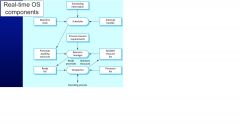![]()
![]()
![]()
Use LEFT and RIGHT arrow keys to navigate between flashcards;
Use UP and DOWN arrow keys to flip the card;
H to show hint;
A reads text to speech;
11 Cards in this Set
- Front
- Back
|
Real-time systems
|
A software system where
the correct functioning of the system depends on the results produced by the system and the time at which these results are produced |
|
|
Soft Vs. Hard real-time system
|
Operation is degraded Vs. operation is incorrect if results are not produced within the time specification.
|
|
|
Periodic Stimuli Vs. Aperiodic Stimuli
|
Predictable time intervals Vs. Unpredictable time
|
|
|
RT (real time) architectural considerations
|

Real-time systems are therefore usually designed as cooperating processes with a real-time executive controlling these processes.
|
|
|
Why is Java not suitable for hard RT?
|
• Not possible to specify thread execution time;
• Different timing in different virtual machines; • Uncontrollable garbage collection; • No standard access to system hardware; • Not possible to do run-time space or timing analysis. |
|
|
JAVA garbage collection
|
Objects that are no longer needed by the program are "garbage" and can be thrown away.
|
|
|
RT systems design process steps
|
1) Identify the stimuli
2) Correspondent time constraints 3)Execution platform: Time, power, team of people, cost 4) Combine the stimulus and response processing into concurrent processes. 5) Design algorithms: time, stimuli and response 6) Scheduling system |
|
|
RTOS (Real Time operation System) components
|

Real-time clock: info for process scheduling
Interrupt Handler: Manages aperiodic requests for service Schedular: Chooses the next process to run Resource Manager: Allocates memory and processor resources Dispatcher: Starts process excution |
|
|
Interrupt Servicing
|
Control is transferred automatically to a pre-determined memory location and given the highest priority to execute action.
|
|
|
Non pre-emptive Vs. Pre-emptive Scheduling
|
Once starts process runs to completion Vs. process can be stopped for higher priority process.
|
|
|
Burglar Alarm System Processes
|

|

